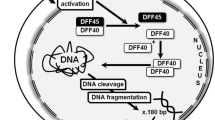Abstract
The structure of the female sex-determining W chromosome was examined in wild-type females and in three mutant female lines of the codling moth, Cydia pomonella. The mutant lines were isolated from progeny of irradiated females using the abnormal appearance of sex chromatin body in female somatic polyploid nuclei as a cytogenetic marker. A detailed cytogenetic analysis was carried out using three different fluorescence in situ hybridization techniques: genomic in situ hybridization (GISH), comparative genomic hybridization (CGH), and fluorescence in situ hybridization (FISH) with the codling moth W-chromosome painting probe. The FISH techniques enabled us to identify the W chromosome and its fragments in mitotic and meiotic chromosome complements and thus helped us to resolve complicated W chromosome aberrations induced by irradiation.












Similar content being viewed by others
References
Anisimov AI, Lazurkina NV, Shvedov AN (1989) Influence of radiation-induced genetic damage on the suppressive effect of inherited sterility in the codling moth (Lepidoptera: Tortricidae). Ann Entomol Soc Am 82:769–777
Bloem S, Bloem KA, Carpenter JE, Calkins CO (1999) Inherited sterility in codling moth (Lepidoptera: Tortricidae): effect of sub-sterilising doses of radiation on field competitiveness. Environ Entomol 28:669–674
Bloem S, Bloem KA, Carpenter JE, Calkins CO (2001) Season-long releases of partially sterile males for control of codling moth, Cydia pomonella (Lepidoptera: Tortricidae), in Washington apples. Environ Entomol 30:763–769
Dyck VA, Gardiner MGT (1992) Sterile-insect release program to control the codling moth Cydia pomonella (L.) (Lepidoptera, Olethreutidae) in British Columbia, Canada. Acta Phytopathol Entomol Hung 27:219–222
Fuková I, Nguyen P, Marec F (2005) Codling moth cytogenetics: karyotype, chromosomal location of rDNA, and molecular differentiation of sex chromosomes. Genome 48:1083–1092
Fukova I, Traut W, Vitkova M, Nguyen P, Kubickova S, Marec F (2007) Probing the W chromosome of the codling moth, Cydia pomonella, with sequences from microdissected sex chromatin. Chromosoma 116:135–145 (Epub 2006)
LaChance LE (1985) Genetic methods for the control of lepidopteran species: status and the potential. ARS-28, US Department of Agriculture, Washington DC, 40 pp
Makee H, Tafesh N (2006) Sex chromatin body as a marker of radiation-induced sex chromosome aberrations in the potato tuber moth, Phthorimaea operculella (Lepidoptera: Gelechiidae). J Pest Sci 79:75–82
Makee H, Tafesh N (2007) Sex chromatin body as a cytogenetic marker of W chromosome aberrations in Cydia pomonella females. In: Vreysen MJB, Robinson AS, Hendrichs J (eds) Area-wide control of insect pests. From research to field implementation. Springer, Dordrecht, pp 113–117
Marec F (1991) Genetic control of pest Lepidoptera: construction of a balanced lethal strain in Ephestia kuehniella. Entomol Exp Appl 61:271–283
Marec F, Mirchi R (1990) Genetic control of pest Lepidoptera: gamma-ray induction of translocations between sex chromosomes of Ephestia kuehniella Zeller (Lepidoptera: Pyralidae). J Stored Prod Res 26:109–116
Marec F, Traut W (1994) Sex chromosome pairing and sex chromatin bodies in W–Z translocation strains of Ephestia kuehniella (Lepidoptera). Genome 37:426–435
Marec F, Neven LG, Robinson AS, Vreysen M, Goldsmith MR, Nagaraju J, Franz G (2005) Development of genetic sexing strains in Lepidoptera: from traditional to transgenic approaches. J Econ Entomol 98:248–259
Ohnuma A (1988) Synthesis of a balanced sex-linked lethal strain in silkworm (in Japanese). Reports of the Silk Science Research Institute vol 36, Tokyo, Japan, pp 17–25
Proverbs MD, Newton JR, Campbell CJ (1982) Codling moth—a pilot program of control by sterile insect release in British Columbia. Can Entomol 114:363–376
Savage JRK (2004) On the nature of visible chromosomal gaps and breaks. Cytogenet Genome 104:46–55
Strunnikov VA (1975) Sex control in silkworms. Nature 255:111–113
Traut W (1976) Pachytene mapping in the female silkworm, Bombyx mori L. (Lepidoptera). Chromosoma 58:275–284
Traut W, Marec F (1996) Sex chromatin in Lepidoptera. Q Rev Biol 71:239–256
Traut W, Weith A, Traut G (1986) Structural mutants of the W chromosome in Ephestia (Insecta, Lepidoptera). Genetica 70:69–79
Traut W, Eickhof K, Schorch JC (2001) Identification and analysis of sex chromosomes by comparative genomic hybridization (CGH). Methods Cell Sci 23:157–163
Weith A, Traut W (1980) Synaptonemal complexes with associated chromatin in a moth, Ephestia kuehniella (L.). Chromsoma 78:275–291
Weith A, Traut W (1986) Synaptic adjustment, non-homolgous pairing of homologous segmentsin sex chromosome mutants of Ephestia kuehniella (Insecta, Lepidoptera). Chromsoma 94:125–131
Acknowledgments
We wish to thank Dr. I.Othman and Dr. N. Mir Ali for their help and support; Ms. Hanady Haroon for technical assistance (The Atomic Energy Commission of Syria, Damascus, Syria), Ms. Iva Fuková for help with laboratory procedures, Ms. Marie Korchová for technical assistance (Institute of Entomology, Ceske Budejovice, Czech Republic), and Dr. A.I. Anisimov (Saint Petersburg, Russia) for introducing H. Makee to codling moth rearing in his lab. This work was funded by Research Contracts No. 10829/R given to H. Makee and No. 12055/R given to F.M. by the International Atomic Energy Agency, Vienna, Austria, and from the Entomology Institute project Z50070508. F. Marec acknowledges support from grants A6007307 of the Grant Agency of the Academy of Sciences of the Czech Republic (till 2005) and 206/06/1860 of the Grant Agency of the Czech Republic (since 2006), both Prague.
Author information
Authors and Affiliations
Corresponding author
Additional information
Communicated by M. Traugott.
Rights and permissions
About this article
Cite this article
Makee, H., Tafesh, N. & Marec, F. Analysis of radiation-induced W chromosome aberrations in the codling moth, Cydia pomonella (L.), by fluorescence in situ hybridization techniques. J Pest Sci 81, 143–151 (2008). https://doi.org/10.1007/s10340-008-0199-8
Received:
Revised:
Accepted:
Published:
Issue Date:
DOI: https://doi.org/10.1007/s10340-008-0199-8




